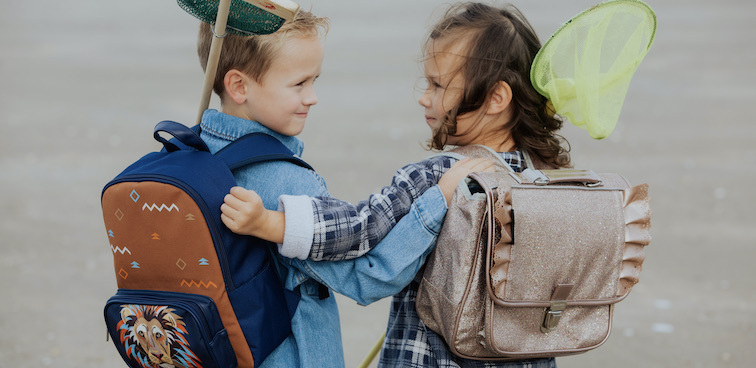Small Spaces, Big Organization: Optimizing Storage in a Small School Bag
Key Takeaways
- Optimizing storage in a small school bag requires creativity and clever solutions.
- Use solutions like multiple compartments and specific bags for extracurricular activities.
- Establish a routine to regularly organize the school bag.
Optimizing space in a small school bag is more than just a necessity – it's a true art form.
A well-organized school bag ensures a stress-free educational experience for children. Imagine a bag where every notebook, every pencil, and every item has its designated place. This bag is meticulously designed to maximize space, maintaining order and accessibility.
An organized school bag reduces the time spent searching for items, preventing any feelings of anxiety in the child. Good organization helps instill management skills from a young age.
Here are a few tips to keep your child's school bag tidy, where each school supply has its place, contributing to a successful and smooth school day.
How to Properly Organize School Supplies in a Small School Bag?
Organizing school supplies in a small school bag can seem challenging, but with the right strategies, it becomes child's play. Here are some proven techniques:
- Use spacious pencil cases: Your child should have a spacious pencil case to store pens and other school supplies. You can also offer them a double pencil case to keep markers and colored pencils separate. This helps keep these small items organized and safe.
- Separation and categorization: A school bag with multiple storage spaces is easier to organize. You can place a large file and small notebooks in the compartment against the back. Small supplies fit perfectly in the small exterior pockets.
- Labeling and personalization: Labeling pockets with subject names can make finding supplies more fun. Personalizing the bag adds a personal touch while being practical. You can add a small card with the child's name if there's a designated spot for it.
- Space-saving tip: For less frequently used items, consider other storage solutions to free up space inside the school bag.
These strategies help to properly organize your child's school bag, aiding in developing organizational skills from a young age.
Tips for Organizing the School Bag at Home
Organizing the school bag doesn't stop at the school door. Maintaining an efficient system at home ensures the bag stays tidy and ready for use. Here are tips for managing school bag organization at home:
- A dedicated zone for the school bag: Establish a specific storage place for the school bag, such as a hook in the hallway or a shelf in the child's room. This creates a routine where your child can consistently place and retrieve their bag from the same spot.
- An organizing routine: Encourage your child to reorganize their bag daily after school to ensure nothing is forgotten and to maintain order inside the bag.
- A dedicated storage space: Your child should have a designated area for school supplies, making it easier to restock the school bag.
- A checklist system: Create a checklist for essential items to bring each day, displayed near the bag's designated spot. Your child can use it to ensure nothing is missing.
- Regular bag cleaning: Implement a weekly routine to completely empty the bag, helping to keep it in good condition, prevent debris buildup, and remove unnecessary items that might add weight.
- Involving the child: Involve your child in the organization process, letting them decide where to store their bag and how to organize it. This promotes independence and organizational skills.
A Backpack Dedicated to Extracurricular Activities
Efficiently managing a small school bag also involves equipment for extracurricular activities. Having a separate backpack just for these activities can simplify your child's life.
A distinct bag for extracurricular activities allows for clear separation between school supplies and sports equipment, avoiding confusion and saving time searching for items in a cluttered bag.
The bag should be suited to your child's specific activities, such as a bag with waterproof compartments for swimming. The idea is to have a functional bag that precisely meets the activity's needs.
Encourage your child to prepare their extracurricular bag the night before to reduce morning stress and ensure no equipment is forgotten. Involving them in managing their extracurricular bag teaches responsibility, helping them manage their schedule and belongings independently.
With a dedicated bag for extracurricular activities, your child enjoys clear and structured organization, easing the transition between school and leisure while keeping both aspects of their life well-organized.



Published the 03/14/2024
Small Spaces, Big Organization: Optimizing Storage in a Small School Bag
- Optimizing storage in a small school bag requires creativity and clever solutions.
- Use solutions like multiple compartments and specific bags for extracurricular activities.
- Establish a routine to regularly organize the school bag.
- Use spacious pencil cases: Your child should have a spacious pencil case to store pens and other school supplies. You can also offer them a double pencil case to keep markers and colored pencils separate. This helps keep these small items organized and safe.
- Separation and categorization: A school bag with multiple storage spaces is easier to organize. You can place a large file and small notebooks in the compartment against the back. Small supplies fit perfectly in the small exterior pockets.
- Labeling and personalization: Labeling pockets with subject names can make finding supplies more fun. Personalizing the bag adds a personal touch while being practical. You can add a small card with the child's name if there's a designated spot for it.
- Space-saving tip: For less frequently used items, consider other storage solutions to free up space inside the school bag.
- A dedicated zone for the school bag: Establish a specific storage place for the school bag, such as a hook in the hallway or a shelf in the child's room. This creates a routine where your child can consistently place and retrieve their bag from the same spot.
- An organizing routine: Encourage your child to reorganize their bag daily after school to ensure nothing is forgotten and to maintain order inside the bag.
- A dedicated storage space: Your child should have a designated area for school supplies, making it easier to restock the school bag.
- A checklist system: Create a checklist for essential items to bring each day, displayed near the bag's designated spot. Your child can use it to ensure nothing is missing.
- Regular bag cleaning: Implement a weekly routine to completely empty the bag, helping to keep it in good condition, prevent debris buildup, and remove unnecessary items that might add weight.
- Involving the child: Involve your child in the organization process, letting them decide where to store their bag and how to organize it. This promotes independence and organizational skills.

Small Spaces, Big Organization: Optimizing Storage in a Small School Bag
Key Takeaways
Optimizing space in a small school bag is more than just a necessity – it's a true art form.
A well-organized school bag ensures a stress-free educational experience for children. Imagine a bag where every notebook, every pencil, and every item has its designated place. This bag is meticulously designed to maximize space, maintaining order and accessibility.
An organized school bag reduces the time spent searching for items, preventing any feelings of anxiety in the child. Good organization helps instill management skills from a young age.
Here are a few tips to keep your child's school bag tidy, where each school supply has its place, contributing to a successful and smooth school day.
How to Properly Organize School Supplies in a Small School Bag?
Organizing school supplies in a small school bag can seem challenging, but with the right strategies, it becomes child's play. Here are some proven techniques:
These strategies help to properly organize your child's school bag, aiding in developing organizational skills from a young age.
Tips for Organizing the School Bag at Home
Organizing the school bag doesn't stop at the school door. Maintaining an efficient system at home ensures the bag stays tidy and ready for use. Here are tips for managing school bag organization at home:
A Backpack Dedicated to Extracurricular Activities
Efficiently managing a small school bag also involves equipment for extracurricular activities. Having a separate backpack just for these activities can simplify your child's life.
A distinct bag for extracurricular activities allows for clear separation between school supplies and sports equipment, avoiding confusion and saving time searching for items in a cluttered bag.
The bag should be suited to your child's specific activities, such as a bag with waterproof compartments for swimming. The idea is to have a functional bag that precisely meets the activity's needs.
Encourage your child to prepare their extracurricular bag the night before to reduce morning stress and ensure no equipment is forgotten. Involving them in managing their extracurricular bag teaches responsibility, helping them manage their schedule and belongings independently.
With a dedicated bag for extracurricular activities, your child enjoys clear and structured organization, easing the transition between school and leisure while keeping both aspects of their life well-organized.